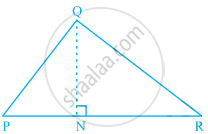Advertisements
Advertisements
प्रश्न
Four points A (6, 3), B (−3, 5), C(4, −2) and D (x, 3x) are given in such a way that `(ΔDBG) /(ΔABG)=1/2,` find x
उत्तर
GIVEN: four points A (6, 3), B (−3, 5) C (4, −2) and D(x, 3x) such that `(ΔDBC)/(ΔABC) `
TO FIND: the value of x
PROOF:
We know area of the triangles formed by three points(x1y1),(x2y2),and (x3y3) is given by `=1/2[x_1(y_2-y_3)+x_2(y_3-y_1)+x_3(y_1-y_2)`
Now
Area of triangle DBC taking D (x,3x),b(-3,5),c(4-2)
`triangleDBC=>1/2[x(5-(-2))+(-3)((-2)-3x)+(4)(3x-5)]`
`triangle DBC=>1/2[7x+6+9x+12x-20]`
`triangle =>1/2[28x-14]`
`triangle=>1/2[14(2x-1]) `
`triangle =>[7(2x-1)]` .......(1)
Area of triangle ABC taking,A(6,3),B(-3,5),C(4,-2)
`=>1/2[x_1(y_2-y_3)+x_2(y_3-y_1)+x_3(y_1-y_2)]`
`=>1/2[6(5-(-2))+(-3)((-2)- 3)+(4)(3-5)]`
`=>1/2[6(7)+(-3)(-5)+(4)(-2)]`
`=>1/2[42+15-8]`
`=>49/2` .......(2)
Also it is given that
`(triangle DBC)/(triangleABC)=1/2`
Substituting the value from (1) and (2) we get
`(triangle DBC)/(triangleABC)=1/2`
`+-(7(2x-1))/(49/2)=1/2`
`2xx7(2x-1)/49=1/2or-2xx7((2x-1))/49=1/2`
`(2x-1)=1/2xx7/2or (-2x+1)=1/2xx7/2`
`2x=7/4+1 or 2x=7/4-1`
`2x=11/4 or 2x=(-3)/4 `
`x=11/8 or x=(-3)/8`
APPEARS IN
संबंधित प्रश्न
Find the values of k so that the area of the triangle with vertices (k + 1, 1), (4, -3) and (7, -k) is 6 sq. units.
Find the area of the quadrilateral ABCD whose vertices are respectively A(1, 1), B(7, –3), C(12, 2) and D(7, 21).
Prove that the points (a, 0), (0, b) and (1, 1) are collinear if `1/a+1/b=1`
The area of a triangle is 5. Two of its vertices are (2, 1) and (3, −2). The third vertex lies on y = x + 3. Find the third vertex.
Show that ∆ ABC with vertices A (–2, 0), B (0, 2) and C (2, 0) is similar to ∆ DEF with vertices D (–4, 0), F (4, 0) and E (0, 4) ?
What is the area of a triangle with base 4.8 cm and height 3.6 cm?
In ∆PQR, PR = 8 cm, QR = 4 cm and PL = 5 cm. 
Find:
(i) the area of the ∆PQR
(ii) QM.
If the points (a1, b1), (a2, b2) and(a1 + a2, b1 + b2) are collinear, then ____________.
Find the missing value:
| Base | Height | Area of parallelogram |
| ______ | 8.4 cm | 48.72 cm2 |
Area of triangle PQR is 100 cm2 as shown in the below figure. If altitude QT is 10 cm, then its base PR is ______.

